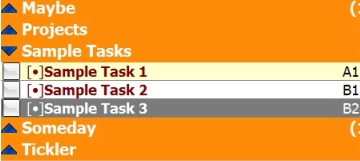Setting Priorities
When you have to choose among several tasks, there are several prioritization tools you can use. Key ones are summarized below. If you are in a rut with your prioritization method, experimenting with the following methods may yield the one that is right for you.
Note that it is commonly recognized that 20% of your activities will account for 80 percent of your success (The Pareto Principle). Hence, if you have 100 tasks in your task list, probably about 20 of those will be the key ones to focus on. Hence, whatever prioritization method you use, you should ensure it helps you pinpoint these tasks.
Covey's Quadrants
Stephen Covey describes a high-level prioritization scheme in his book The Seven Habits of Highly Effective People. In this scheme, tasks are categorized by four quadrants:
- QI - Important and Urgent
- QII - Important but Not Urgent
- QIII - Not Important but Urgent
- QIV - Not Important and Not Urgent
Dr. Covey notes that highly effective people make time for the QII activities, and that doing so can reduce the time spent in other quadrants. While QI - QIV prioritization doesn't help you decide which QI activity to do first and which to do second, and so on, it can be very enlightening to find out which quadrants your tasks are in.
The ABC Method
I first became aware of this scheme when I used a paper-based Franklin planner.
It ranks tasks into three categories:
- A = vital
- B = important
- C = nice
Then it subdivides tasks in these categories into A1, A2, A3, ..., B1, B2, ... and so forth. Note that the A, B, C categories have a straightforward correspondence to Quadrants I, II, and III discussed in Covey's The 7 Habits of Highly Effective People.
A lot of people find this prioritization method to be very helpful. Although the standard Pocket PC and Palm Task list application does not support these exact priorities, there are some very good third party applications that do. For example, Pocket Informant and Agenda Fusion for the Pocket PC support prioritization and add a number of other useful capabilities. The following is a screenshot showing task prioritization within Pocket Informant:

If you use Microsoft Outlook, you are probably already aware that it has three priority settings for a task: High, Normal, Low. These of course correspond directly to the A, B, C priorities. Pocket Outlook on Pocket PCs and Smartphones use the same priority scheme as Outlook.
Palms use a numeric rating of 1 - 5 for prioritizing tasks. When synced with Outlook, priorities 1 and 2 are translated to Outlook's "High" priority, priority 3 is translated to "Normal," and priorities 4 and 5 are translated to "Low."
The Payoff versus Time Method
With this method, you weight each task by the payoff you expect from it versus the time it takes to do it. Tasks that have high payoff and that take little time are the ones you would do first. Correspondingly, tasks that have low payoff and that take a lot of time are ones you would do last or not at all.
Paired Comparison
This method uses a simple scoring system for comparing activities. The following example illustrates how to apply this method.
Here is the list of example tasks:
| 1. Call wife about dinner plans |
| 2. Fire Billy Bob |
| 3. Draft budget report |
| 4. Respond to e-mails |
Compare the following and put a check mark against the winner of each comparison:
- 1 to 2, 1 to 3, 1 to 4
- 2 to 3, 2 to 4
- 3 to 4
Let's say the result of this is as follows:
| 1. Call wife about dinner plans | XX |
| 2. Fire Billy Bob | XXX |
| 3. Draft budget report | X |
| 4. Respond to e-mails |
So, the order you would do the tasks in would be 2, 1, 3, 4.
Closing Thoughts
Sometimes priorities shift. We've all had to juggle tasks. On balance, though, we need to ensure our priorities are consistent with our personal goals and the goals of our organizations. Doing this requires a periodic review, and a weekly planning session is ideal for this.
Also, while the message has been out for years that organizations should clearly communicate their goals and priorities, research continues to show that many organizations are not good at this. Hence, you may need to make an effort to identify the goals and priorities of your organization, to ensure your priorities are consistent with those.
Finally, to emphasize what was pointed out earlier, you should take full advantage of the Pareto Principle. The best discussion I have ever seen of this is in Tim Ferriss' book The 4-Hour Workweek: Escape 9-5, Live Anywhere, and Join the New Rich. While the title of this book makes it sound like one of the millions of get-rich-quick hypes, this is truly a phenomenal book about lifestyle design with some great discussions of managing time and setting priorities. Amazon is practically giving it away at its $12 price. I am personally convinced that Ferriss is the New Time Management Guru.
Help me continue to improve this site by giving me your feedback. My email is brucekeener at gmail.com.
© 2001 - 2008 Bruce Keener
Search within Keen PDA and Keener Living:
